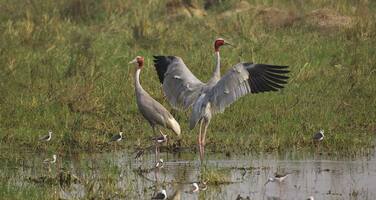Keoladeo National Park
Factors affecting the property in 1997*
- Invasive/alien terrestrial species
- Other Threats:
Decline in the population of Siberian cranes
Factors* affecting the property identified in previous reports
- Insufficient water delivery
- Possible invasion of Paspalum grass
- Decline in the population of Siberian cranes
International Assistance: requests for the property until 1997
Total amount approved : 0 USD
Missions to the property until 1997**
Information presented to the Bureau of the World Heritage Committee in 1997
This site, also recognized as a wetland of international importance under the RAMSAR Convention, is a wintering ground for several important species of migratory birds, including the Siberian cranes. In the late 1980s the Committee received reports from IUCN and expressed concerns regarding the decrease in the population of wintering Siberian cranes in Keoladeo and management problems, such as the over-growth of grasses, forming a thick mat in some areas and thereby adversely affecting the breeding habitat of the Siberian cranes.
Records maintained by Park management indicated that the wintering population of Siberian cranes, estimated at about 38 in 1985-86 when the site was inscribed on the World Heritage List, had dropped to 5 in 1992-93; no Siberian cranes were seen in Keoladeo during 1993-95. Participants at the Meeting of the South Asian World Natural Heritage Sites, held in New Delhi, India, during 16-19 January 1997, undertook a field visit to Keoladeo and observed 3 Siberian cranes which have returned to this World Heritage site for the 1996-97 winter.
The Indian authorities, recognizing that the decrease in the number of Siberian cranes arriving to winter at Keoladeo is attributable to the intensity of hunting and other factors prevailing along the migratory route of the species, have signed a Memorandum of Understanding (MOU) established among nine countries, i.e. Afghanistan, Azerbaijan, India, Islamic Republic of Iran, Kazakstan, Pakistan, Russian Federation, Turkmenistan and Uzbekistan, whose territories constitute the range of the central and western Asian populations of the Siberian crane. The MOU has been established under the auspices of the Convention of Migratory Species of Wild Animals (CMS), to which UNEP, which hosts the Secretariat of the CMS, International Crane Foundation (ICF) and the Wild Birds Society of Japan are also signatories. Under the MOU, an action plan has been drawn up and foresees: (i) the release of captive-bred Siberian cranes to augment wild populations; and (ii) capturing of Siberian cranes and the deployment of satellite transmitters on the cranes for tracking their migratory route from their wintering areas in Keoladeo to spring breeding grounds in other countries. At the site level, the management has introduced a controlled burning and cutting regime for grasses in order to limit their growth from negatively impacting the breeding habitats of the cranes and closed the Park for grazing by cattle belonging to local villagers.
A scientific compilation on all the RAMSAR sites of India, including the Keoladeo World Heritage Area, has been recently published by the World Wide Fund (WWF) for Nature of India.
Action Required
The Bureau takes note of the Memorandum Of Understanding established among the range States of the central and western Asian populations of the Siberian crane and urges the Centre to maintain communications with the Secretariat of the Convention of Migratory Species of Wild Animals (CMS) in order to know the progress in, and support the implementation of the action plan.
Summary of the interventions
Decisions adopted by the Committee in 1997
21 BUR IV.B.22
Keoladeo National Park (India)
The Bureau recalled the fact that the Committee had previously expressed concerns regarding the decrease in the population of wintering Siberian cranes returning to this site and management problems, such as the over-growth of grasses, forming a thick mat in some areas were adversely affecting the breeding habitat of the Siberian cranes. Records maintained by Park management indicated that the wintering population of Siberian cranes, estimated at about 38 in 1985-86 when the site was inscribed on the World Heritage List, had dropped to 5 in 1992-93; no Siberian cranes were seen in Keoladeo during 1993-95. In 1996-97 three Siberian cranes have returned to Keoladeo National Park.
The Bureau noted that the State Party, recognizing that the decrease in the number of Siberian cranes arriving to winter at Keoladeo may be attributable to the intensity of hunting and other threats prevailing along the migratory route of the species, have signed a Memorandum of Understanding (MOU) with the eight countries (Afghanistan, Azerbaijan, Islamic Republic of Iran, Kazakstan, Pakistan, Russian Federation, Turkmenistan and Uzbekistan) with whom it shares the range of the central and western Asian populations of the Siberian crane. UNEP, which hosts the Secretariat of the Convention on Migratory Species (CMS), International Crane Foundation (ICF) and the Wild Birds Society of Japan are also signatories to the MOU, under which an action plan foresees: (i) the release of captive-bred Siberian cranes to augment wild populations; and (ii) capturing of Siberian cranes and the deployment of satellite transmitters on the cranes for tracking their migratory route from their wintering areas in Keoladeo to spring breeding grounds in other countries. At the site level, the management has introduced a controlled burning and cutting regime for grasses in order to limit their growth from negatively impacting the breeding habitats of the cranes and closed the Park for grazing by cattle belonging to local villagers. The Bureau urged the Centre to cooperate with the CMS Secretariat and support the implementation of the action plan.
* :
The threats indicated are listed in alphabetical order; their order does not constitute a classification according to the importance of their impact on the property.
Furthermore, they are presented irrespective of the type of threat faced by the property, i.e. with specific and proven imminent danger (“ascertained danger”) or with threats which could have deleterious effects on the property’s Outstanding Universal Value (“potential danger”).
** : All mission reports are not always available electronically.


